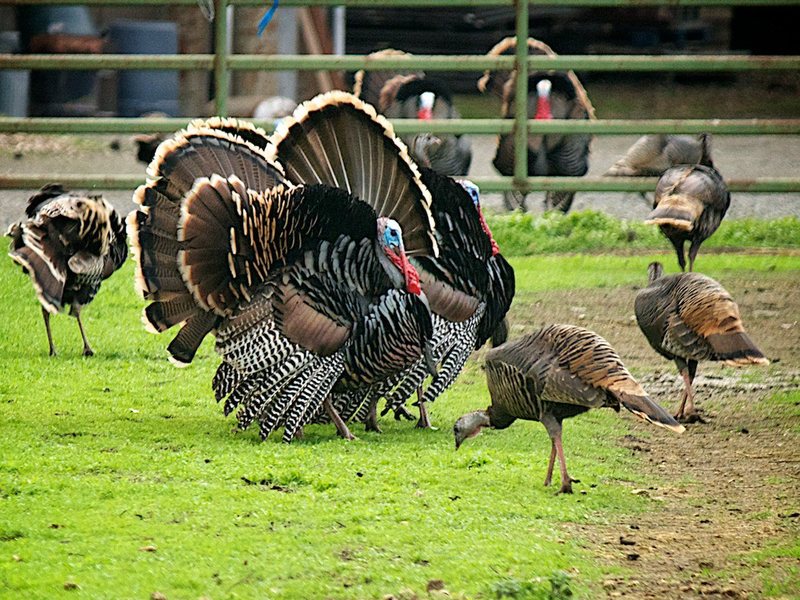5 things to learn about turkey farms
Turkeys are not naturally vegetarians Turkeys are not vegetarians, but omnivores. Turkeys raised on pasture and wild turkeys eat bugs and worms in additional to grass and other vegetation. However, consumer demand for “vegetarian fed” has led companies to add a vegetarian diet option to their feeding program to accommodate what the customer wants while […]

Turkeys are not naturally vegetarians
Turkeys are not vegetarians, but omnivores. Turkeys raised on pasture and wild turkeys eat bugs and worms in additional to grass and other vegetation. However, consumer demand for “vegetarian fed” has led companies to add a vegetarian diet option to their feeding program to accommodate what the customer wants while meeting the turkeys’s nutritional needs. Certain flocks (a group of turkeys) are not fed any meat or meat by-products, despite that being what Mother Nature intended them to eat, so they can have “vegetarian fed” on the label.
The feed will change approximately 10 times over the course of a turkey’s life to meet its nutritional needs. Turkeys have their own nutritionist, a Butterball employee, who monitors their feed and creates the recipes for each stage of life. Their diet includes vitamins and probiotics. As the nutritionist told us, “Nothing we put in turkey feed can’t be put in my mouth.”
Raising turkeys is a 365-day job, and not just for the farmer
The farmer told us he comes out to the barns on Christmas morning just like any other day. He can’t leave for a weekend at the beach when he has turkeys on the farm. Every day, the farmer walks through each turkey house at least twice. Each barn has its own set of computers monitoring everything from temperature to feed. A backup system kicks in if the main system fails. His cell phone will get an alert if something is wrong at one of the turkey houses, day or night.
It’s not just the farmer who’s on call. The company veterinarian recalled getting a call about sick turkeys one Sunday morning. He was at the farm later that day to check the turkeys.
Turkeys need a prescription
No antibiotics are stored on the farm. If a farmer is concerned about one turkey or the entire flock, he contacts his farm’s service technician or the company veterinarian. If treatment is required, the veterinarian writes a prescription, which is sent to the warehouse to be dispersed.
If the entire flock needs treatment, an antibiotic can be added to the water or feed. Strict withdrawal times are observed to make sure the medicine has worked through the turkey’s system before it is sent for processing.
Butterball has a diagnostic lab, which performs autopsies (called a necropsy) on animals that died on the farm to determine cause of death. This information will help the veterinarian decide what course of action, if any, is needed to ensure the remaining turkey’s health.
Just for the record, the only hormones in turkey are the ones they naturally have. In fact, it is illegal to give turkeys, chickens, or other poultry added hormones or steroids.
Young turkeys lose baby feathers
The turkeys we saw had been on the farm less than a week. When the veterinarian picked one up, I noticed a few spots on it’s body without feathers. I asked about it and learned when turkeys first hatch they have down, or soft, fluffy baby feathers. Turkeys will naturally lose their baby feathers and grow adult feathers. It reminded me of my son losing his baby teeth.
I was also surprised to learn turkeys don’t have feathers on 100% of their body; some areas are naturally featherless.
Turkeys like each other, really like each other
Have you seen photos of a turkey house and all the birds are huddled together? You may have thought they were standing close because they didn’t have room to spread out. You’d be wrong.
When we walked into the turkey house, I was taken aback by how spacious it is. If you’ve ever walked onto a football field, have you noticed how long it is? The playing field is 100 yards, or 300 feet. This turkey house was twice that; it was 600 feet long. There was a lot of open space, yet the turkeys were all in the same general area. Turns out, turkeys are sociable birds and like to be around each other. Given the choice, they will stick together.
The turkeys gathered around us and moved as a group while we walked through the turkey house. We walked through the middle of the flock, which was like the parting of the Red Sea, but they soon gathered together again. Once they decided we weren’t interesting anymore, they moved away and went back to doing turkey things. The farmer called it “popcorning”, I just called it happy turkeys.
Source: Successful Farming
